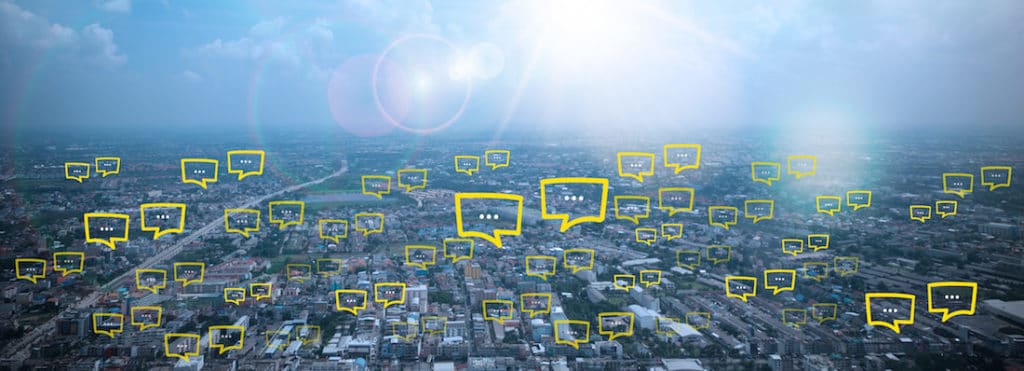After years of being heralded as a hot emerging trend, the Internet of Things (IoT) is finally a reality.
Business Insider estimates that 6.6 billion IoT devices are now in the market, and that there will be 22.5 billion devices in use by 2021. The same analysis projects that there will be $4.8 trillion in aggregate IoT investment by 2021.
Already consumers are purchasing things like internet-connected televisions and smart speakers at scale. Companies have gone even further: GE’s Predix platform, which is used by more than 22,000 developers to create industrial IoT applications, has become a $6 billion business.
For many digital marketers, the rise of the Internet of Things is both exciting and somewhat confusing. The convergence of physical objects and the internet is clearly bringing changes, but determining exactly what those are can be difficult.
However, by taking a step back — and looking beyond the hype — it is possible to see a few clear shifts and opportunities. In particular, here are five key ways the Internet of Things is set to impact marketing.
New advertising opportunities & formats
Perhaps the most visible effect that IoT is having on marketing is that it is creating new advertising opportunities for brands. After all, when almost any object can be connected to the Internet, almost any object can become a channel for engaging consumers.

This means once far-fetched ideas — such as using refrigerators to advertise food products and car dashboards to highlight nearby gas stations — are now feasible.
Beyond these straightforward uses are any number of more unexpected approaches. For example, with its Dash buttons Amazon has created a powerful product marketing channel by simply combining a WiFi receiver and some plastic.
On the other end of the spectrum, Burger King already tried to use a traditional television ad to trigger the Google Home devices of consumers.
These are just the tip of the iceberg. As more devices become Internet enabled — and as marketers get more creative — a wealth of new IoT advertising opportunities should open up for brands.
Staggering amounts of valuable data
Although the emergence of new advertising channels is exciting, the true power of IoT for marketers lies in something else: the data.
Cisco estimates the total amount of data generated by Internet-connected objects will reach 600 ZB per year by 2020. That’s a mind-boggling amount of information (1 ZB — zetabyte — equals 1 trillion gigabytes).
This wealth of data will be not just deep, but also broad. It will be generated by everything from watches to product packaging, shipping containers, medicine dispensers, and suitcases.
This isn’t just Big Data, it’s Enormous Data. it will give marketers the ability to truly understand the specific behaviors/needs of individual consumers and it will make it possible to deliver the exact right messaging in the exact right place at the exact right time. That should dramatically increase the effectiveness of marketing efforts.
An accelerated shift to smart platforms
All the data generated by IoT objects is only useful if it can be harnessed. Similarly, constantly delivering messaging to countless objects effectively is a complex undertaking.
In other words, to capitalize on the potential of the Internet of Things marketers will have to increasingly utilize technology.

Of course, this move towards platforms — databases, automation tools, programmatic ad programs, etc. — has been happening for years. Long gone are the days when most marketing programs could be managed with a simple spreadsheet.
However, the rise of the IoT will require an entirely new level of scale and sophistication. Technology stacks will need to be smarter and more powerful; they will need to be able to handle vast amounts of data, intelligently deliver the right messaging, and learn from the results.
These needs should be on the mind of every marketer: soon having a strong tech foundation will be not just nice-to-have, but an absolute necessity for brands.
New roles and responsibilities for marketers
Beyond the nitty-gritty of new advertising possibilities, data sources, and technology needs, the rise of the IoT raises some existential questions that marketers will need to grapple with.
The biggest of these is the broadest. Simply put: What is marketing?
In the past, the role of a marketer was fairly clear: a firm had a product/service and it wanted to encourage people to make a purchase. Marketing was the bridge; it influenced human beings to take action.

The Internet of Things has the potential to fundamentally alter this dynamic. For example, imagine the day — likely not that far off — when a coffee machine can sense when it is running low on beans, automatically check the Web for the lowest-priced product that matches with its owner’s tastes, and place the order.
What role does a marketer for a coffee roasting company play in that situation? Most likely it will involve a range of things — overseeing meta-tagging, managing dynamic pricing systems, etc. — that go beyond traditional responsibilities.
That’s not to say that the IoT will kill marketing by any means. Rather that it will transform and expand what it means to be a marketer.
A shift how marketers create & collaborate
Finally, another high-level issue that marketers will have to grapple with is how they work.
As smart objects become increasingly omnipresent, internal responsibilities at firms will overlap and merge. Marketers’ roles will likely blend with areas like sales and product development.
Unfortunately, many traditional work approaches — siloed groups, step-by-step campaign launches, etc. — are ill-suited for this fluid, fast-moving environment.
Just as marketer’s roles will increasingly involve technology, their ways of tackling tasks will need to increasingly come to resemble that of tech workers. Specifically, many of the methods that enable development teams to work collaboratively and iteratively — scrums, agile approaches, open task management, etc. — could be invaluable for marketers to embrace.
The Internet of Things is set to change not just the execution of marketing — how ads are delivered, what data is harnessed, which platforms are utilized — but also the very nature of the function itself. Ultimately, as the objects around us evolve, so too will marketers need to become smarter and better.





Join the conversation